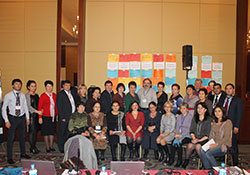Subregional intersectoral training for the central Asian republics on antimicrobial resistance from a food safety perspective

WHO
Antimicrobial resistance (AMR) is a significant public health problem that is receiving increasing attention worldwide. Any kind of antibiotic use in people, animals or plants can promote the development and spread of antibiotic resistance.
On 23–27 November 2015, training took place in Tashkent, Uzbekistan to build capacity in the central Asian republics on AMR from a food safety perspective, focusing on coordinated surveillance of AMR in the foodborne pathogens Salmonella and Campylobacter. Emphasis was put on intersectoral cooperation and information sharing in line with the European Health 2020 framework, which calls for a health in all policies approach and intersectoral collaboration.
This training was funded by WHO through voluntary funds donated through the European Commission–The Netherlands Partnership Agreement.
It brought together approximately 40 relevant national professionals from Kazakhstan, Kyrgyzstan, Tajikistan, Turkmenistan and Uzbekistan, both microbiologists and epidemiologists, from the public health, food safety and veterinary sectors. The microbiologists had extensive practical training on isolation, identification and antimicrobial sensitivity testing for Salmonella and Campylobacter. They also participated in introductory training in the Laboratory Quality Stepwise Implementation tool, including an exercise on process analysis.
Background
Resistance to antibiotics is also a food safety concern considering the use of antibiotics in food animals for treatment, disease prevention or growth promotion, thus allowing resistant bacteria and resistance genes to pass through the food chain from food animals to humans. Resistance in the foodborne zoonotic bacteria Salmonella and Campylobacter is clearly linked to antibiotic use in food animals, and foodborne diseases caused by such resistant bacteria are well documented in people.
Of special concern is resistance to so-called critically important antibiotics for human medicine. For example, the use of fluoroquinolones in food animals has led to a corresponding antibiotic resistance in Salmonella and Campylobacter.
Tackling AMR requires a multifaceted holistic approach, which includes collaboration, cooperation and information-sharing between the public health and the veterinary sectors. Addressing the use of antimicrobial agents in the food chain and the occurrence and spread of AMR in the food chain is an important aspect of the efforts to combat AMR.



